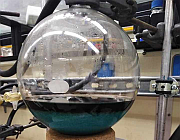Citation:
Levason W, Nirwan M, Ratnani R, Reid G, Tsoureas N, Webster M. Transition metal complexes with wide-angle dithio-, diseleno- and ditelluroethers: Properties and structural systematics. Journal of the Chemical Society. Dalton Transactions. 2006;(4):439 - 448.
Abstract:
The ligands o-C6H4(CH2EMe)2(E = S or Se) have been prepared and characterised spectroscopically. A systematic study of the coordination chemistry of these, together with the telluroether analogue, o-C6H4(CH2TeMe)2, with late transition metal centers has been undertaken. The planar complexes [MCl2(o-C6H4(CH2SMe)2)] and [M(o-C6H4(CH2EMe)2)2](PF6)2(M = Pd or Pt; E = S or Se), the distorted octahedral [RhCl2(o-C6H4(CH2EMe)2)2]Y (E = S or Se: Y = PF6; E = Te: Y = Cl) and [RuCl2(o-C6H4(CH2EMe)2)2] (E = S, Se or Te), the dithioether-bridged binuclear [(RuCl2(p-cymene))2(μ-o-C6H4(CH2SMe)2)] and the tetrahedral [M′(o-C6H4(CH2EMe)2)2]BF4(M′ = Cu or Ag; E = S, Se or Te) have been obtained and characterised by IR and multinuclear NMR spectroscopy (1H,63Cu,77Se(1H),125Te(1H) and195Pt), electrospray MS and microanalyses. Crystal structures of the parent o-C6H4(CH2SMe)2and seven complexes are described, which show three different stereoisomeric forms for the chelated ligands, as well as the first example of a bridging coordination mode in [(RuCl2(p-cymene))2(μ-o-C6H4(CH2SMe)2)]. These studies reveal the consequences of the sterically demanding o-xylyl backbone, which typically leads to unusually obtuse E–M–E chelate angles of ∼100°. © 2006 The Royal Society of Chemistry.
